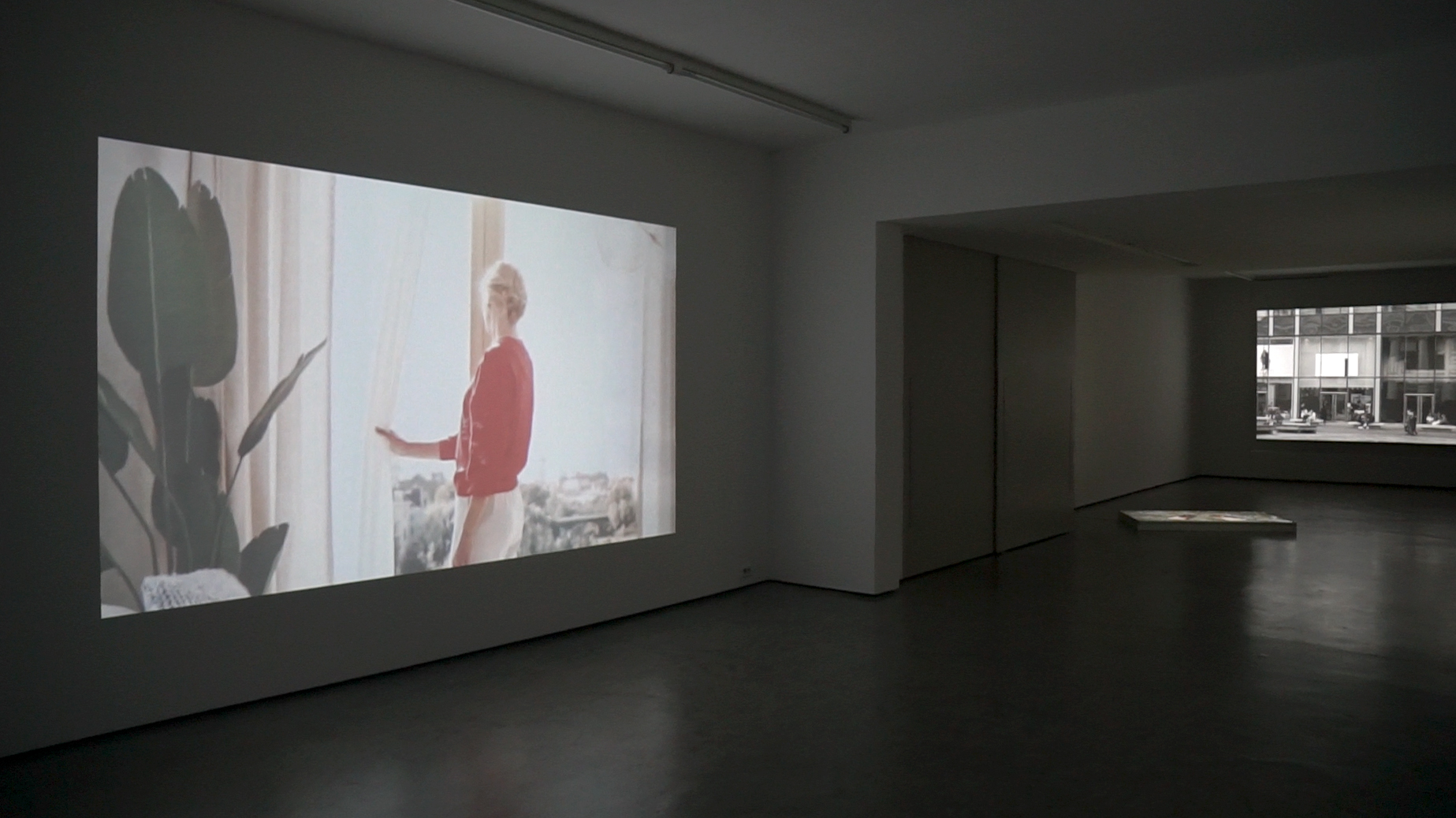14 november 2023, Wouter van den Eijkel
Last chance: Emma van der Put - Places you prefer
‘Do It’, ‘Cannot be stopped’, ‘Places you prefer’ and ‘you, tomorrow’ could easily be lines from a poem, but are fragments of text Emma van der Put has found in public spaces in Brussels. In her most recent films, she juxtaposes the contemporary human image conveyed by these phrases with the notions that once shaped those places. It's a dialogue within a work, but the texts also spark conversation between the films and other artworks.

Emma van der Put, you, tomorrow, installation view, tegenboschvanvreden
A work of art that engages in dialogue is a cliché, but one that is usually associated with paintings, installations and sculptures. In video art, initiating dialogue is trickier, especially because each video work requires a separate dark space for viewing.
Emma van der Put (NL, 1988) successfully overcomes these challenges. The two wall-sized projections, Passage I and II in you, tomorrow, Van der Put's second solo exhibition at galerie tegenboschvanvreden, are presented in a relatively bright space and resemble a stroll through an exhibition of paintings. The works are interconnected by the lightboxes of the diptych wework on the wall and the smaller, symbolic video work Dweller on the floor.
Van der Put not only circumvents the dark space, but also addresses the notion of viewers entering a film midway, missing its essence. Her films lack a clear beginning and end. Previously a filmmaker, she based the two Passage films on photographs taken in her living and working space in Brussels.

Emma van der Put, Dweller, 2015, videoloop, tegenboschvanvreden
The right moment
The images are not staged or edited, but presented to Van der Put as they are. By frequenting the film locations, the story inherent in each place gradually unfolds and Van der Put captures the moment. "I rely on moments when everything aligns, when certain things are more visible than at other times. The moment is very important for me."
Patience and intuition also play a major role in Van der Put's visual language. The video collages guide you at a slow pace, gradually revealing their meaning. But this meaning is not unequivocal or immediately apparent; rather, the images provide an impression, a starting point. Moreover, as the viewer, you often maintain a considerable distance from the subject, giving Van der Put's work a voyeuristic quality. "That distance is more or less inherent to the use of a camera. The lens creates a private space within the public space. This produces a fusion of intimacy and distance, the position I look for in my work." Van der Put explains during an artist talk at the gallery.

Emma van der Put, still, Passage I, tegenboschvanvreden
Do It
The idea for the works in you, tomorrow was born during the lockdowns. While strolling through the deserted centre of Brussels, Van der Put noticed a significant amount of text in public spaces. Advertisements in bus shelters, shop windows and on buildings, now speaking in vain without passers-by. She incorporated them into her new films. The slogans and short texts often appear only partially visible, like Do It, with the word ‘Just’ missing. Together these text fragments form a kind of poem, with the metaphorical message more apparent than the literal one. By featuring in both films, the works engage in an almost literal conversation.
Van der Put deliberately selected places in the city with a clear function and explores the language used in her films. Passage I unfolds in the shopping gallery of Brussels and the adjacent shopping streets. Images of a 19th-century tympanum and Art Nouveau facade alternate with neon and other advertising, as well as contemporary facade texts. The slow interplay of text fragments and architectural elements raises questions about how humans perceive themselves across different time periods, the dreams we have and the future outlook embedded in them.

Emma van der Put, still, Passage II, tegenboschvanvreden
In the new Passage II, Van der Put turns her camera to Brussels' canal zone, an industrial area that deteriorated after its heyday and is now undergoing extensive renovation. The film is set in a former goods train station recently modernised into a public courtyard with shops and flexible office spaces. Here, too, short phrases emerge, this time to sell office spaces. Slowly, persuasive texts emerge like ‘Guide to better living,’ ‘This is where we like to work’ and ‘Places you prefer. It might be easy to dismiss these texts as empty and meaningless, but Van der Put doesn't; she merely presents them to us and places them alongside historical material.
In Passage II, Van der Put reveals how a location is marketed and explores our thoughts about work and workplaces, as the past also surfaces here in the form of images of the workers who once laboured at the station. The former employees are summoned again to feature in promotional materials and on the billboards of a real estate project. The past is utilised here to serve projects in the present.
Next year, Passage III will follow, the third and final film in this series, focusing on the European district. Unlike the Brussels shopping heart and the real estate project, nothing is for sale there. The marketing is political. "In addition to the voice of the major political institutions, the voice of passers-by is also strongly present in the form of graffiti, stickers and abandoned protest signs. That film will engage in dialogue with those different voices," Van der Put anticipates.

Emma van der Put, you, tomorrow, installation view, tegenboschvanvreden
